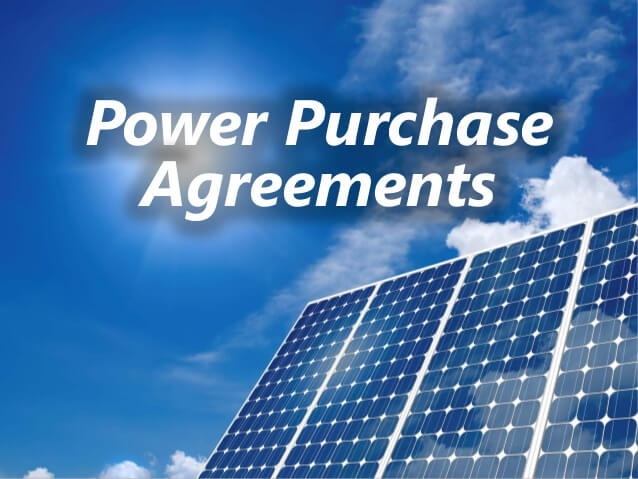This article is written by Vihanka Narasimhan, currently studying law at Jindal Global Law School, O.P. Jindal University. This article attempts to explain the concept of power purchase agreements in India and around the world. A comprehensive understanding of the subject matter, historical significance, legal provisions, advantages and limitations of power purchase agreements have also been discussed in this article.
This article has been published by Sneha Mahawar.
Table of Contents
Introduction
Electricity is an essential element for the socio-economic development of a country. It is crucial for every institution, be it a business, a school, an office or a hospital; all of them having different energy needs. For example, a hospital may not require as much energy as a factory. It is in these situations that the use of power purchase agreements can be seen to bridge the gap between the demand for and availability of electricity. Such a demand is met with large capital contributions by private companies that pose as a consumer and the government who is a supplier. Traditionally, the agreement between these parties results in a power purchase agreement. In a nutshell, a power purchase agreement can be simply understood as a legal contract between an electricity generator and a power purchaser.
Definition of a Power Purchase Agreement
A power purchase agreement which is also known as a PPA can be defined as a long-term electricity supply agreement between two parties, usually between a power producer and a customer who can be a consumer or trader of that electricity. The agreement stipulates conditions such as the amount of electricity to be supplied, the negotiated prices for the time period, accounting formalities, and penalties for non-compliance among many other things. A power purchase agreement is a bilateral agreement which makes it inclined to variability in each case as it is tailored to the needs of the customer. Generally, electricity can be supplied physically (physical power purchase agreement) or on a balancing sheet (virtual power purchase agreement). The motive of this agreement is to protect the consumer from market price hikes resulting from energy, ultimately resulting in reduction of investment costs associated with planning or operating. The provider on the other hand benefits from a study flow of financial income. In India, central and state utility power purchase agreement’s contractual terms last for 25 years, whereas nascent private power purchase agreements are around 5-10 years. The following is how a purchase agreement starts:-
“This Power Purchase Agreement (PPA) is executed on___ (date), ___(month),____ (year) at < location> between _________ Authorized representative of Purchaser < i.e. Government Organization, PSU and Offices > (detail address), (hereinafter referred to as “Purchaser”) AND M/s (Name of Power Producer) (CIN No. ______________), a company incorporated under the Companies Act, 1956/2013 having its registered office at _________________ (detail address) (hereinafter referred to as “Power Producer” which expression shall, unless repugnant to the meaning or context hereof, be deemed to include its successors and assigns). The Purchaser and Power Producer are each individually referred to as a “Party” and collectively as the “Parties”.”
Reasons to enter into a Power Purchase Agreement
There can be many reasons that urges a business to enter into a Power Purchase Agreement. The most common ones have been listed below:-
- For a business, management of energy can prove to be very tedious either due to a lack of expertise or limited resources. In such a scenario a business can opt to enter into a power purchase agreement as the next best alternative to investing and managing energy. The businesses with energy requirements are commercial and industrial customers with little to no technical expertise.
- A business can only be successful when financial aspects are taken into consideration with the future in perspective. In such a scenario a business can opt to enter into a power purchase agreement as a safeguard against energy price hikes in the future and even result in a study supply of energy for renewable energy projects.
- A business can have an agenda to shift towards a cleaner source of energy. This change may arise out of environmental consciousness or simply as a tool for fulfilling a business’s Corporate Social Responsibility (CSR) criteria. In the case of the latter, it is generally targeted towards clients, employees, shareholders, banks and governments for gaining goodwill.
- A business is run on profits and power purchase agreements are financial drivers. A business might consider entering into a power purchase agreement to mitigate potential business risks arising out of energy needs and may even help reduce the financial burden by saving on energy bills.
Types of Power Purchase Agreements
There are mainly two types of power purchase agreements. They have been discussed below:-
Physical Power Purchase Agreement
A physical power purchase agreement can be defined as a contract that allows the purchase of power or energy from a particular energy generator (also known as the seller) to a purchaser of that energy (also known as the buyer). In such an agreement, the buyer is entitled to the physical delivery of (or title to the) electricity through a source which is known as a grid. In general, physical power purchase agreements are entered into from anywhere between 10 and 20 years. The agreement stipulates various terms and conditions of sale of energy between the buyer and the seller such as the amount, charges, payment and termination of the power supplied. In a nutshell, a physical power purchase agreement is basically a long-term contract between the buyer and seller of the energy wherein the seller is held liable for the risks involved in owning and operating the system which provides energy. Such a system can be either on the buyer’s property (on-site) or off-site. It is essential to note that physical power purchase agreement can be of two types: –
On-site Power Purchase Agreements
Power purchase agreements are considered to be “on-site” in a situation wherein the source of energy production equipment is installed on a buyer’s location. In this case, the seller is responsible for the funding, installment, operation and maintenance of such equipment and the buyers merely act as a host to such equipment whilst availing its benefits. For example, in case a business agrees to set up solar panels on its site of operation. This would aid the buyer to obtain protection against increasing energy prices which is definite to happen in the future and also help in obtaining fixed energy prices for the duration of the contract in exchange for equipment setup.
Off-site Power Purchase Agreements
Power purchase agreements are considered to be “off-site” in a situation wherein the source of energy production equipment is not installed on a buyer’s location. They however can be physical in the sense that the source of energy is supplied from the seller’s facility located in a nearby area in accordance with the contract. This type of agreement is useful, particularly for businesses which do not have the resources to install and employ the equipment required to produce energy. Further, it is suitable for businesses who wish to have various energy options to choose such as solar, wind or thermal.
Virtual Power Purchase Agreement
Virtual power purchase agreement is alternatively known as a financial power purchase agreement. As the name suggests, it can be described as a financial contract between the buyer and the seller by the means of exchanging a fixed-price cash flow for a variable-priced cash flow and renewable energy certificates (RECs). This type of power purchase agreement does not include the physical delivery of power and is rather sourced from traditional channels. Basically, the power is sold on the wholesale electricity market at a defined location and the buyer fulfils his energy on the basis of providing a fixed price (which is agreed upon between the buyer and the seller) for each unit of power produced.
Comparison between Physical Power Purchase Agreement and Virtual Power Purchase Agreement
From the above discussion, one can figure out that both the physical and virtual power purchase agreement provides businesses with many benefits with regards to cost-effectiveness and energy efficiency, sometimes also being eco-friendly in nature (in case of use of renewable energy), it is, however, crucial to note that there is a key difference between both of them. They have been elaborated in brief in the table below:-
| Basis | Physical Power Purchase Agreement | Virtual Power Purchase Agreement |
| Type of Agreement | It is physical in nature and is hence a purchase agreement. | It is financial in nature and is hence a monetary agreement. |
| Suitability | It is most suited for businesses that have a concentrated electricity load. | It is most suited for businesses that have a distributed electricity load. |
| Location | The location of the business is a significant criterion as it is essential for the buyer to be located near the source of the energy facility. | The location of the business is not a significant criterion as this method can be used to source energy with the aid of traditional channels. |
| Additional costs | There may be an initial cost of setting up involved in a situation where the buyer decides to install the power equipment on-site for energy consumption. | The buyer bears no setup cost as the contract is financial in nature. |
| Risks | Only one source of energy is available which can prove to be disadvantageous in case there are technical issues with the source equipment. | It is possible for the business to observe wholesale power prices to expect a fall into negative values during periods of low demand. |
Historical background of Power Purchase Agreements in India
In India, the inception of power purchase agreements started with the amendment of the Electricity Act of 1910. The amendment took place sometime around the time India underwent the process of globalisation which required the country to open its gates to the foreign market. The Indian government observed that the electricity sector started to become a subject to privatisation and foreign investment and introduced an incentive that provided a five-year tax holiday for new projects in the power sector and a guaranteed 16% return on foreign investment. This, however, was unsuccessful as most companies struggled with achieving closure for their energy projects, despite having obtained most of the other required clearances. Apart from this, the incentive was a massive failure as there were major delays finalising power purchase agreements and even if the projects were approved the cost of energy estimated for the projects were sky-high.
In order to tackle all these problems, the government introduced the electricity bill in the year 2000 which allowed for major changes in form of delicensing generation and permitting power trading. The main aim of the Bill was to encourage power reform by providing the states flexibility in terms of allowing them to choose models which they deemed was suitable. Another aim here was to ensure that the market is competitive. This was achieved by setting up Power Trading Corporation (PTC) which at the time was visualised as a medium where power could be traded wherein PTC purchased power from mega power projects and sold it to different states. The government took this step to ensure that there was no monopoly in the sector and as a provision to permit others to acquire licences and trade in power. The government had aspired to add 100,000 MW of power capacity in the next 12 years which at that time was equivalent to would be equal to the total power produced in the last 53 years.
The aim however proved to be too ambitious and it was decided that in order to achieve the set target, the encouragement of the private sector to contribute towards the power sector was necessary. This decision led to the present legislation of ‘the Electricity Act, 2003’ which was passed on 10th June 2003. The Act aimed at introducing competition to the power sector by allowing de-licensing of thermal generation, open access in transmission, open-access of the distribution network in phases, multiple licensing in distribution zones and de-licensing of rural electricity supply. Basically, this Act aided in the delicensing of generation of power in India by opening the market of electricity generation to private players opening the gates to power purchase agreements.
Legal provisions of Power Purchase Agreements in India
In India, electricity is a ‘concurrent’ subject that comes under the purview of Entry 38 List III implying that the power sector is handled by both the state and the central governments, allowing for enactment rights to both governments in this regard. The central government usually takes care of the policy framework while the state governments concentrate on specific issues. Currently, the power sector is being governed by the Electricity Act, 2003 which has been described as “An Act to consolidate the laws relating to the generation, transmission, distribution, trading and use of electricity and generally for taking measures conducive to the development of electricity industry, promoting competition therein, protecting the interest of consumers and supply of electricity to all areas, rationalization of electricity tariff, ensuring transparent policies regarding subsidies, promotion of efficient and environmentally benign policies, the constitution of Central Electricity Authority, Regulatory Commissions and establishment of Appellate Tribunal and for matters connected therewith or incidental thereto.” Section 49 of the Electricity Act, 2003 deals with an agreement for the purchase and supply of electricity. Further, the government after abolishing Section 5 of the Electricity (Supply) Act, 1948 has made it mandatory in the current provision for all State Electricity Boards (SEBs) to unbundle into separate generation, transmission and distribution entities. As per Electricity Act, 2003 state electricity board has to be unbundled and make it into three companies that are recognised under the Companies Act, 2013. They can engage in the generation, distribution and transmission of power.
Essential clauses to take care of while drafting a Power Purchase Agreement
It is very evident from the discussion up until now that power purchase agreements have become a huge deal in the Indian ecosystem which calls for a meticulously drafted power purchase agreement. The following are some of the essential elements that are bound to be included in a power purchase agreement: –
Definitions
Power purchase agreements are highly complex in nature. This makes it essential that all the terms specified in the agreement have been defined in a simple language for mutual understanding of all the parties involved. This is mainly done so as to avoid confusion or any sort of complication with respect to the arrangement. Most of the power purchase agreements contain ‘Definitions and Interpretations’ as the first clause, this however can also be attached in the annexure to make the document brief and easy to understand.
In a power purchase agreement, the following can be treated as examples: –
““Power Purchase Agreement” or “PPA” : The PPA is the Power Purchase Agreement entered between the REPD and NDMC for the purchase of the power generated by the Project and purchased from the REPD by the NDMC.
“Unit Commercial Operation Date (UCOD)” : shall mean the actual commissioning date of the respective Unit(s) of the Project where upon the REPD starts supplying power from the Project to the Delivery Point
“Metering point” : metering is to be conducted at the Delivery Point where the power, provided by the REPD for purchase by the NDMC
Length of the agreement
The determination of the length of the agreement is crucial while getting into a power purchase agreement. They are usually long-term commitments spanning approximately from 15-25 years between the parties involved. This clause will provide details with respect to the agreement’s date of commencement, tenure of the agreement, provision in case of early termination, and survival.
In a power purchase agreement, the following can be treated as an example: –
“This Agreement shall be valid for a term commencing from the Effective Date until the Expiry Date (“Term of Agreement”), unless terminated earlier pursuant to Article ____. Upon the occurrence of the Expiry Date, this Agreement shall, subject to Article ___, automatically terminate, unless mutually, extended by all the Parties on mutually agreed terms and conditions, at least ninety (90) days prior to the Expiry Date, subject to the approval of the Electricity Regulatory Commission.”
Fulfilment of subsequent conditions
When a buyer and a seller enter into a power purchase agreement, generally in order for the commencement of the said agreement it is mandatory that certain conditions are fulfilled by the buyer as well as the seller. These conditions are to be fulfilled in a stipulated period which is usually 12 months or more. The conditions vary from agreement to agreement due to its flexible nature. The most common conditions are obtaining all permits, getting approval from the government, sending notices to the contractor, etc. In case of non-compliance by either party, damages have to be paid as compensation to the other party. Apart from this, it is crucial to note that this clause also includes any amendments and/or joint responsibilities of the buyer and the seller which would be subject to legal consequences in case of non-fulfillment.
“Satisfaction of conditions subsequent by the Seller
The Seller agrees and undertakes to duly perform and complete the following activities at the Seller’s own cost and risk within ____ months from the Effective Date:
[List of activities]
Satisfaction of conditions subsequent by the Procurer
The Procurer agrees and undertakes to duly perform and complete the following activities at the Procurer’s own cost and risk within ____ months from the Effective Date:
[List of activities]”
Power supply
This is indisputably the most important part of the agreement. Basically, the person who is selling or producing the power grants permission to the buyer to make use of it in accordance with the PPA. Further, this clause also specifies the type of power purchase agreement the involved parties are entering into. It can vary from being an on-site PPA, off-site PPA or even a virtual PPA.
In a Purchase Power Agreement, the following can be treated as an example: –
“Commencement of Supply of Power to Procurer
According to the terms of this Agreement, the Seller is responsible for supplying power up to the aggregated contracted capacity by the scheduled delivery date, which is [DATE]. The Seller and the Procurer may, however, mutually agree to begin supplying power in stages beginning on the Revised Scheduled Delivery Date.
The Seller shall give the Procurer at least ____ days written notice of the date on which it intends to commence supply of power.”
Charges for Available Capacity and Output
It is important to keep in mind that the charging process is a pass-through agreement. A pass-through arrangement can be understood as an arrangement between the contracting authority and service provider for a fixed rate in accordance with the employer’s contribution rate. If this amount varies, the service provider can recover the amount of any increase from the contracting authority through an adjustment to the contract price. In a nutshell, the availability fee can be seen on the basis of availability of power in the power plant and on the other hand, the variable charge can be seen on the basis of the amount of power delivered. The purchaser wants guarantees for long-term output from the project and so the producer will levy an availability charge, which typically is the minimum that it will be paid, provided that the plant can be shown to make sure power is available.
In a power purchase agreement, the following can be treated as an example: –
“Allocation of Generation Capacity
The Seller shall provide ___ % of the Power Station’s Net Capacity to the Procurer as per the terms of this Agreement.
Availability
The Seller must adhere to the provisions of the relevant Law relating to Availability, including, in particular, the provisions of the Code relating to declarations of Availability and related matters.”
Details on Billing and Payment
This clause in the power purchase agreement provides clarity with regards to details involving the payments and billings arising out of the agreement. The clause covers contents such as the mode of payments, the cycle of billing, delivery of bills, payments that have already been made (prepayment) and/or due date to make payments in the future (deferred payments). This clause can further also provide for a provision which discusses the charges arising out of fluctuation in the prices and/or any additional charges to be paid.
In a power purchase agreement, the following can be treated as an example: –
“General
For the commencement of supply, the Procurer shall pay the Seller the monthly Tariff Payment, consisting of Tariff for each Contract Year, calculated in accordance with this Article ___ and Schedule ___, on or before the Expiry Date. All Tariff Payments by the Procurer shall be in Indian Rupees.
Delivery of Monthly Bills/Provisional Bills
The Seller must provide the Procurer with a signed Monthly Bill for the preceding Month no later than ten (10) days into the following Month. If the Monthly Bill for the previous Month is released after the tenth (10) day of the following Month, the Due Date for payment of that Monthly Bill will be extended by thirty (30) days.”
Force Majeure
Force Majeure can be understood as the non-completion of a task due to unexpected or unforeseen circumstances or situations like a war, terrorist attack, pandemic, etc. In such a situation, there is no need to pay damages for delays resulting from events which are beyond one’s control.
In a power purchase agreement, the following can be treated as an example: –
“Force Majeure
‘Force Majeure’ means any event or situation, including those mentioned below, that completely or partially prevent or unavoidably delays an Affected Party from performing its obligations under this Agreement, but only if and to the extent that such events or circumstances are beyond the Affected Party’s rational control, directly or indirectly.
[LIST OF ACTIVITIES]”
Change of Law
In India, energy laws are subject to constant change. It is essential to keep in track the change of law as it may lead to an impact on tariff and it will also serve as a guide in such a scenario for making adjustments and providing relief to the parties involved.
“Change of Law
“Change of Law” refers to any of the following incidents occurring after the date that is seven (7) days prior to the Bid Deadline and resulting in any new recurrent or non-recurring expenditure by the Seller or any income to the Seller:
[LIST OF INCIDENTS]”.
Termination of Agreement
Finally, there should be a clause providing for the termination of the agreement. Such termination can happen at the end of the term of the agreement or in the middle due to some default by one of the parties. The main objective of the clause is to lay grounds for termination is to give a mutually decided remedy to the defaulting party within a given time frame or to seek compensation for specific performance.
In a power purchase agreement, the following can be treated as an example: –
“Events of Default and Termination
Seller Event of Default:
A Seller Event of Default is described as the occurrence and continuation of any of the following events unless they are caused by a Force Majeure Event, a violation by Procurer of its obligations under this Agreement, or a Procurer Event of Default:
[List of events]”
Procurer Event of Default
The occurrence and the continuation of any of the following events, unless any such event occurs as a result of a Force Majeure Event or a breach by the Seller of its obligations under this Agreement or a Seller Event of Default, shall constitute the Event of Default on the part of defaulting Procurer:
[List of events]”.
A power purchase agreement also consists of other clauses such as clauses regarding dispute resolution, obligations of the parties, metering, liability and indemnification, insurance, warranties of the parties, the relationship of the parties and other miscellaneous things. It is very important to understand that there is no fixed format for a power purchase agreement and the ones discussed above are some of the standard clauses which almost all kinds of agreements irrespective of their purpose have in common.
Advantages of Power Purchase Agreements
Predictability
In most of the cases, power purchase agreements provide long-term price security as these agreements usually last from 15-25 years. For this long tenure, a business does not have to anticipate any risk which may rise out of price hikes in power. This makes the future cost in this realm fixed and hence predictable.
Clean and green business
Apart from ensuring predictability and cost-effectiveness, power purchase agreements can also be eco-friendly in nature. This can happen in cases where the power consumed by the business is renewable in nature, i.e., produced with the help of solar panels, wind turbines, etc. It can further help a business achieve Corporate Social Responsibility (CSR) towards the governments and shareholders whilst collecting goodwill.
Cost-effectiveness
It is a known fact that the cost of energy is closely relative to the cost of production. This implies that energy would lead to an increase in power. Keeping in mind that power purchase agreements usually last from 15-25 years and the power industry is highly volatile (due to supply and demand, reservoir levels, reserve power, charges etc.), the buyer is signing up cost saving in the long run.
Limitations of Power Purchase Agreements
Fall in energy prices
The power industry is highly volatile and power purchase agreements usually last from 15-25 years which is a long period of time. This makes us consider the possibility wherein the future price of the energy which is being traded in the market falls below the price which the buyer and the seller have mutually agreed on. Such a situation can lead to monetary loss and eventually lead to setbacks with respect to the business competitors. In order to mitigate such a risk, periodic reassessments should take place mutually between the buyer and the seller.
Forecasting consumption requirements
The power needs of a business are determined by analysing the price, demand, supply, etc. in the market from the past over a period of time. Probability calculated from all the relative factors can either be right or wrong making it highly unreliable. Moreover, it is highly difficult to understand the subtleties of energy consumption of their operations. In order to mitigate such a risk, negotiation of tools such as delivery of energy according to load, flexibility, or flat contracting may help.
Non-Compliance
In a power purchase agreement, just like any other contract, there are usually two parties involved, the buyer and the seller. This leads to the possibility of default on one of the parties’ ends. In order to mitigate such a risk, the agreement should have set provisions on non-compliances for a quick resolution.
Termination of a power purchase agreement
A power purchase agreement is a long-term agreement and usually lasts anywhere from 15 to 25 years. After the successful term, the buyer and seller have to plan for the next step in alignment with market conditions, business prospects, energy costs, etc. Generally, on the termination of a power purchase agreement, the buyer and the seller have three options which are as follows: –
- Negotiate the PPA’s terms (usually in the form of a slightly higher rate) which would lead to a continuation of the partnership between the buyer and the seller.
- Purchasing the energy equipment from the seller and installing it at the buyer’s facility.
- The conclusion of the partnership between the buyer and the seller would lead to the dismantling the setup used during the power purchase agreement.
Conclusion
The energy industry is booming in India with the Central Electricity Authority (CEA) predicting for the country to have an energy surplus of 6.4 percent and a peak surplus of 8.2 percent in the financial year of 2022. In context to this, a power purchase agreement can prove to be an indispensable tool to add value to one’s business as it enables one to get ahead of his/her business competitors, make smart investment choices and strategizing with regard to future risks and establishing a sense of your commitment towards sustainability and eco-friendliness. In order to fully reap the benefits of power purchase agreements, it is essential to meticulously analyse and negotiate the terms and conditions before signing the agreement to avoid complications and confusion which may lead to termination or payment of damages. In conclusion, power purchase agreements are not merely legal contracts between a power provider and a power purchaser but a business opportunity with a potential for high returns.
References
- https://echs.gov.in/img/Policy/Pers%20Section/Solar/Annexure-IV_Model%20PPA%20Agreement.pdf
- https://cercind.gov.in/Act-with-amendment.pdf
- https://blog.ipleaders.in/important-clauses-power-purchase-agreement/
- http://www.swachhbharaturban.gov.in/writereaddata/PPA_NDMC.pdf
- https://powermin.gov.in/sites/default/files/uploads/Overview_of_the_Model_Power_Purchase_Agreement.pdf
- https://www.lexisnexis.co.uk/legal/guidance/power-purchase-agreements-ppas-key-terms-issues
- https://www.homeproca.com/power-purchase-agreements/
Students of Lawsikho courses regularly produce writing assignments and work on practical exercises as a part of their coursework and develop themselves in real-life practical skills.
LawSikho has created a telegram group for exchanging legal knowledge, referrals, and various opportunities. You can click on this link and join:
Follow us on Instagram and subscribe to our YouTube channel for more amazing legal content.
 Serato DJ Crack 2025Serato DJ PRO Crack
Serato DJ Crack 2025Serato DJ PRO Crack












 Allow notifications
Allow notifications



